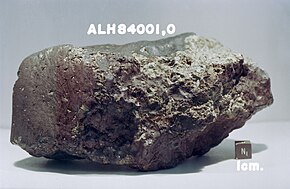| Allan Hills 84001 | |
|---|---|
 Meteorite fragment ALH84001 | |
| Type | Achondrite |
| Clan | Martian meteorite |
| Grouplet | Orthopyroxenite |
| Composition | Low-Ca Orthopyroxene, Chromite, Maskelynite, Fe-rich carbonate[1] |
| Shock stage | B |
| Weathering grade | A/B |
| Country | Antarctica |
| Region | Allan Hills, Far Western Icefield |
| Coordinates | 76°55′13″S 156°46′25″E / 76.92028°S 156.77361°E[1] |
| Observed fall | No |
| Found date | 1984 |
| TKW | 1930.9 g |
Allan Hills 84001 (ALH84001[1]) is a fragment of a Martian meteorite that was found in the Allan Hills in Antarctica on December 27, 1984, by a team of American meteorite hunters from the ANSMET project. Like other members of the shergottite–nakhlite–chassignite (SNC) group of meteorites, ALH84001 is thought to have originated on Mars. However, it does not fit into any of the previously discovered SNC groups. Its mass upon discovery was 1.93 kilograms (4.3 lb).
In 1996, a group of scientists found features in the likeness of microscopic fossils of bacteria in the meteorite, suggesting that these organisms also originated on Mars. The claims immediately made headlines worldwide, culminating in U.S. president Bill Clinton giving a speech about the potential discovery.[2] These claims were controversial from the beginning, and the wider scientific community ultimately rejected the hypothesis once all the unusual features in the meteorite had been explained without requiring life to be present. Despite there being no convincing evidence of Martian life, the initial paper and the enormous scientific and public attention caused by it are considered turning points in the history of the developing science of astrobiology.[3]
- ^ a b c "Meteoritical Bulletin Database: Allan Hills 84001".
- ^ "President Clinton Statement Regarding Mars Meteorite Discovery". https://archive.is/yTTe.
{{cite web}}: External link in|website= - ^ Cite error: The named reference
disbeliefwas invoked but never defined (see the help page).